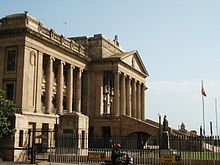State Council of Ceylon
| State Council of Ceylon | |
|---|---|
| British Ceylon | |
| Type | |
| Type | |
| History | |
| Established | 1931 |
| Disbanded | 1947 |
| Preceded by | Legislative Council of Ceylon |
| Succeeded by | Parliament of Ceylon |
| Seats | 58 |
| Elections | |
|
Last election
|
Ceylonese State Council election, 1936 |
| Meeting place | |
 |
|
| The State Council building in Galle Face Green, Colombo. The building was used by the State Council's successors (the House of Representatives of Ceylon, National State Assembly, and Parliament of Sri Lanka) until 1982. Today it is known as the Old Parliament Building and houses the Presidential Secretariat. | |
The State Council of Ceylon was the unicameral legislature for Ceylon (now Sri Lanka), established in 1931 by the Donoughmore Constitution. The State Council gave universal adult franchise to the people of the colony for the first time. It replaced the Legislative Council of Ceylon, the colony's original legislative body.
There were only two State Councils: the First, elected in 1931, and the Second, elected in 1936. The 1947 Soulbury Constitution replaced the State Council with the Parliament of Ceylon, as part of a process of constitutional development leading up to independence, which took place on 4 February 1948.
Due to Ceylonese demands for constitutional reform, a royal commission was established by the British authorities under the chairmanship of the Earl of Donoughmore. The Donoughmore Commission arrived in the colony in 1927, before returning to the United Kingdom where it issued its report. The Commission proposed reforms which were implemented as the so-called Donoughmore Constitution, resulting in the abolution of the Legislative Council of Ceylon as the colony's legislature, and its replacement by a "State Council" in 1931.
The structure and working of the State Council was experimental, and was based in part on the United Kingdom's London County Council. The State Council functioned in both an executive and legislative capacity, with seven committees performing executive duties. Each committee consisted of designated members of the State Council, and was chaired by an elected Ceylonese who was addressed as minister. The Ceylonese ministers formed a board of ministers with three British officials of ministerial rank who handled defence, external affairs, finance, and judicial matters.
...
Wikipedia
